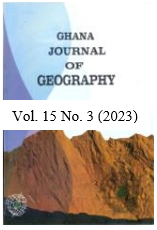Seasonal Differences in Rainfall Distribution Within the Bawku Area in the Savanna Belt of Ghana
Abstract
Empirical evidence suggests that temperatures are continuously rising in the savannah areas of Ghana and impacting negatively on residents’ livelihood activities. However, there is paucity of information on the wet and dry seasons’ rate of wetness or dryness in the driest belt of Ghana. Meanwhile, residents of the area are mainly rained agriculturalists. We employed gauge station rainfall and temperature data from Ghana Meteorological Agency to assess the seasonal rainfall characteristics of the Bawku area using XLSTAT and DrinC software. Results from the rainfall anomalies show persistent dryness (-0.017) in the area during the dry season and continuous wetness in the wet season (0.021). Evapotranspiration was consistently higher in the dry season at a rate of 2.6% (0.26) yearly as well as a high rate of aridity [AI] (0.00≤AI≤0.09) in the dry season and low aridity (0.56 ≤AI ≤1.13) during the wet season. Following the reduction in the amount of rainfall, we can conclude that Bawku area is continuously drying amidst the changing climate. It is recommended that the ministry of agriculture should prioritise the construction of mechanised dams or wells and expand irrigation projects in the area to reduce the climate change effects on the livelihood of the residents especially in the dry season.




